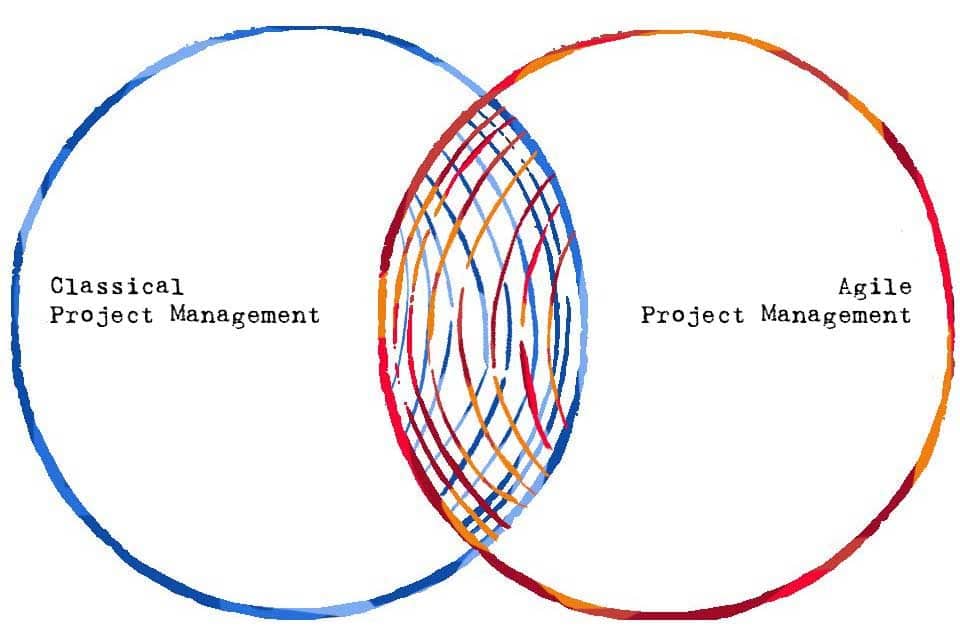What is Hybrid Project Management?
Table of Contents: Definition – Combinations and examples – Motives and objectives – Roles – Values – Importance of PMO – Download – Notes
Smartpedia: Hybrid Project Management describes the combination of at least two project management approaches with the aim of sharing the respective advantages.
Hybrid Project Management Definition
Hybrid Project Management refers to the combination of different project management methods or the use of individual elements of different project management approaches. Alternative terms are often bimodal, selective, adaptive or multimodal project management, but the expressions emphasise different aspects differently:
- The term “hybrid” stands for the combination, mixing or crossing of “something”. In a technical environment, a hybrid refers to the combination of different technologies, such as in the automotive industry for a drive with gasoline and electricity. Applied to project management, a hybrid approach thus describes the integration of different methods (e.g. PMI and Scrum) or the use of different elements of different methods (e.g. user stories from Scrum and software specifications from V-Modell XT).
- Bimodal project management propagates a combination of exactly two management systems.
- Selective project management addresses a selection of the most suitable elements from different methods and approaches.
- Adaptive project management focuses on an approach adapted to the project and the associated challenges. As such, the term is somewhat more comprehensive.
- The multimodal project management stresses the combination of more than two different project management methods and/or – systems and is therefore – together with the selective project management – closest to the term of the hybrid project management.
The broader the term “Hybrid Project Management” is understood, the clearer it becomes that it has long been a reality in organisations and that that pure project management methods are rather an exception. In summary, Hybrid Project Management describes the combination of different project management methods or parts of these methods with the goal of using the advantages of different approaches in one project.
Hybrid combinations and examples
In most cases, hybrid project management is understood as a combination of traditional, classic project management methods with agile techniques. This is obvious, as standardised approaches such as PRINCE2 Agile or agile strategies in V-Modell XT have been around for many years. However, there are also agile combinations – e.g. a combination of Scrum and Kanban – and traditional combinations – e.g. project planning with PRINCE2 and the development of a system using a waterfall. There are therefore three basic possible combinations: classic and agile, agile and agile, and classic and classic.
There are also other combinations, e.g. classic with agile and agile. Example: The project is planned holistically with PRINCE2, the realisation of requirements is carried out with a combination of Scrum and Kanban, i.e. with Scrumban.
- a daily developer meeting in V-Modell XT to coordinate with each other
- a retrospective as a lessons learnt meeting in Hermes
- a stakeholder review meeting for release acceptance in V-Modell XT Bund
- a business case in Scrum
- a backlog in PRINCE2
- an earned value analysis in Scrum
- an impediment board in V-Modell XT Bund
Under the keyword Scrumbut you will find some deviations from Scrum that relate to roles and artefacts.
Motives and objectives of hybrid approaches
Companies use methods for managing projects for a wide variety of reasons: they try to prioritise the quality of results, adherence to deadlines and customer orientation. They address internal teamwork or employee motivation. Companies often operate in sectors that pose particular challenges in terms of safety, documentation and traceability. Verification obligations and compliance with standards, for example, can lead to the selection of a methodology that places great emphasis on planning and the creation of documents.
In addition, in many organisations, procedures have grown methodically over a longer period of time or are even prescribed from outside (for example, the V-Modell XT is to be used as a process model for projects of German federal authorities). Although hybrid project management aims to utilise the best of different management systems, the motive may be to meet the specific requirements of the industry and at the same time use useful elements of other approaches. And even if a company wants to use Scrum as an agile framework from now on, the hybrid approach helps to combine tried-and-tested and useful aspects of the current approach with components of the agile approach. The blog post Subversively agile describes how this works in practice.
Roles in hybrid project management
What roles are there in hybrid project management?
In traditional projects, the project manager is responsible for planning and implementation and therefore also for the success of the project. They ensure compliance with defined workflows and are allowed to realise the requirements defined at the start of the project at defined costs and deadlines.
The role of project manager does not exist in agile projects. Scrum, for example, recognises a product owner who represents the ideas of the stakeholders, maintains the backlog and combines product and project management tasks. The Scrum Master is responsible for adhering to the agreed process and supports the development team. The development team is responsible for finalising a potentially deliverable increment in accordance with previously made commitments. Neither the Product Owner nor the Scrum Master are superior to the team.
These approaches are so different that every company should think about roles, tasks and responsibilities from the outset as part of hybrid project management. This is the only way hybrid project management can work.
Values as the foundation for hybrid project management
Hybrid project management is often understood as classic project management that is expanded to include agile techniques. In a traditional project, for example, a process or an area such as software development can be carried out in an agile manner using extreme programming or a single ritual such as the daily scrum or retrospective can be used.
The use of agile techniques is often accompanied by the desire to eliminate the supposed weaknesses of traditional project management: Employees are overloaded, priorities and responsibilities are unclear and the number of meetings is too large. However, the advantages of agile working do not arise from the few roles, events and artefacts, but from shared values and principles. Agile techniques emphasise, among other things, self-organisation, individual and team responsibility, as well as iterative and flexible working. Hybrid project management only has a chance of permanently improving the status quo in projects if such values and principles are practised.
The growing importance of project management offices in the choice of approach
Many companies work in a hybrid way – some departments use agile methods, while others continue to be organised in the traditional way. This hybrid way of working reflects the reality: only a few companies work completely agile, and the appropriate method is often chosen depending on the project or department.
In this context, the project management office (PMO) plays a crucial role. It ensures that the various project management approaches – whether agile, classic or hybrid – are coordinated. The PMO ensures that each method fits into the existing structures and is adapted according to project requirements.
A PMO also helps companies to flexibly decide which approach is best suited to a specific project. In some cases, a classic approach may make more sense, in others agile working. By specifically selecting the right method, the PMO helps to implement projects successfully and efficiently – especially in complex, hybrid environments in which different teams and approaches work together.
In short, in a world where hybrid ways of working are becoming the norm, the PMO is the key to finding the right balance between agility and structure and ensuring the success of projects.
Download the Hybrid Project Management Guide for free now.
Everything important about hybrid project management at a glance.
- What is hybrid project management and what possible combinations are there?
- What motives and goals lead to hybrid project management?
- What are hybrid organisations and what challenges do many companies face?
- What examples of hybrid project management are there?
Knowledge on 7 pages to take away.
Haven’t hybrid approaches to planning and implementing projects or developing products and services been the rule rather than the exception for a very long time?
Notes:
Some publications talk about Hybrid Project Management 2.0. On the one hand, this is an attempt to promote a “new” approach for a digital transformation, on the other hand, it refers to the Whitepaper Hybrid Project Management in version 2.0 – published by IPMA.
If you like the article or would like to discuss it, please feel free to share it in your network. And if you have any comments, please do not hesitate to send us a message.
Here you can find additional information from the t2informatik Blog:




